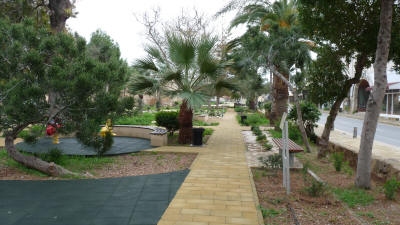Desdemona Park
Famagusta, North Cyprus
 |
| Desdemona Park |
Desdemona Park is the smallest and newest park area in Famagusta. It can be found next to the walls, between the Sea Gate and Othello’s Tower. In the early years of the British occupation, it was utilised as a storage area for materials and equipment used for the extension and rebuilding of Famagusta harbour. More recently it was used as a traffic roundabout (or perhaps oblong-about would be more accurate!) However, the road layout in the area was such that most traffic ignored the one-way aspect of the road system. So the decision was made to admit defeat and return to two-way traffic, pedestrianise the road close to the walls, and to create an eco-friendly garden between the two.
The project was funded by the United States Agency for International Development (USAID) through their SAVE (Supporting Activities that Value the Environment) project. The park was officially opened on the 21st May 1010.
The entire park has been designed to create a uniquely Cypriot public space which both honours and protects Cyprus’ valuable environment and natural resources. This lush landscape, redolent with native herbs, plants and flowers is planted entirely with drought tolerant and low-water use flora in order to save water and reflect the area’s natural environment. Native Cypriot plants are used extensively, along with other plants native to the Mediterranean region. This makes them uniquely suited to thrive with the harsh summer climate and infrequent but harsh winter rainfall on Cyprus.
Every element of this of this park has been designed to protect Cyprus’ natural resources. The park features xeriscape landscaping, otherwise known as water-wise gardening. Here several methods of water-efficient gardening are being used:-
 |
| The Fountain and Dry Garden |
*All of the plants, bushes and trees are native to the region, which
makes them drought-tolerant and well-adapted to the climate,
requiring little or no water.
*A drip irrigation is calibrated to the plants' needs. Where
possible, watering takes place during the cooler part of the day to
minimise water evaporation. Plants are not irrigated during the
rainy season.
*Compost is mixed into the soil to help retain moisture.
*Mulch insulates the soil, keeping it moist and cool. This also
aids weed suppression.
*A small grass area of around 5% of the planted area helps reduce
water demand.
*Regular maintenance, which keeps plants trimmed and controls weeds,
further reduces water demand.
This all means that, compared to a traditional garden, the park saves around 4 tonnes of water every week.
In the centre of the park, there is a decorative fountain. Built in the 1950s, and restored by SAVE during the garden’s construction, it is a replica of a 16th Century fountain, built by the Venetians for the garden of the Monastery of Ayia Napa in Larnaca, where the original can still be found. Around the fountain is a circular area planted as a “dry garden”, where absolutely no irrigation is used. This is achieved by the use of cacti and succulents, providing an attractive landscape requiring no artificial watering.
Besides showcasing the functionality and beauty of a water-wise landscape, the park provides a welcome respite for visitors and locals alike. There is a small children’s play area, and numerous seats where you can relax and soak up the atmosphere.
See the location on Google maps.
Back to Famagusta index.